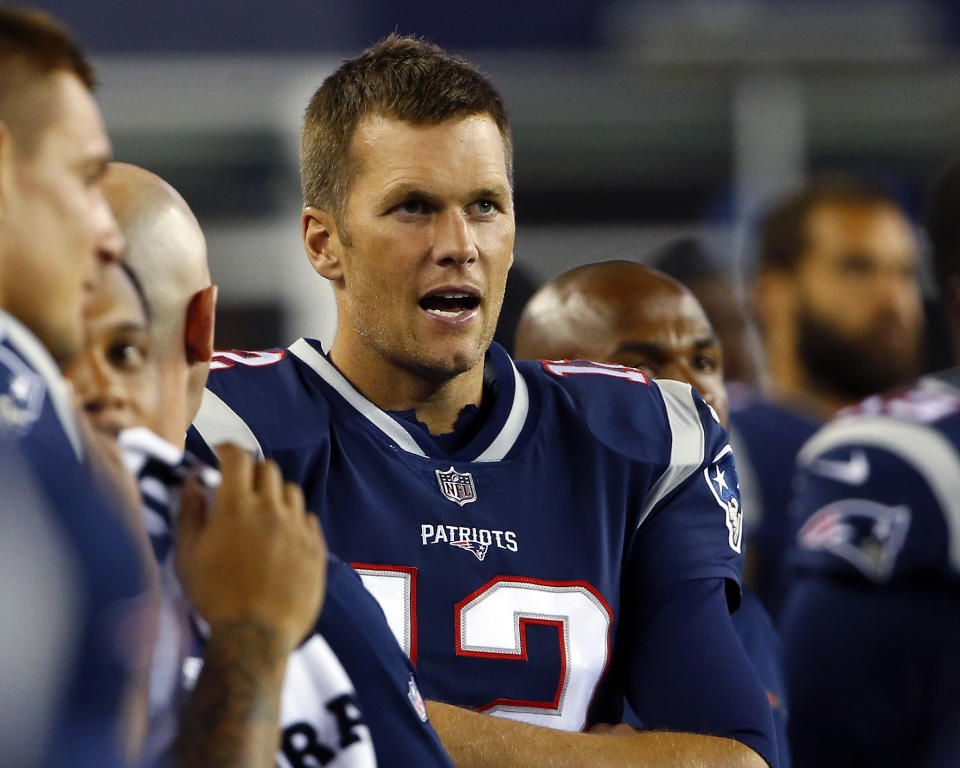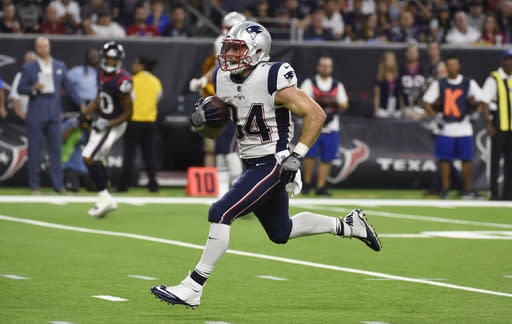Juggernaut Index, No. 6: Brady leads unstoppable attack, but Pats backfield a mess

Few athletes in any sport have delivered decade-long periods of dominance like the one Tom Brady produced from 2007 to 2016. It borders on total mastery of craft. Over the past 10 NFL seasons, Brady’s passer-rating was 102.5. He averaged 7.8 yards per attempt. Six percent of his throws resulted in touchdowns. He’s had the lowest interception rate in the league in four of the past eight seasons, including the last two. He’s led his team to seven conference title games and four Super Bowls in 10 years. Since 2007, his regular season record as a starter is 113-28-0.
Brady’s absolute ownership of the NFL can’t really be denied, even by those who view his franchise as a sort of roving Death Star. We’re under no obligation to like the Patriots, but facts are facts. Brady has been almost impossibly good.
[Now’s the time to sign up for Fantasy Football! Join for free]
Just look at some of the key stats he produced to bookend his ridiculous 10-year run:
2007 – 300.4 YPG, 68.9 cmp%, 8.3 Y/A, 8.7 TD%, 1.4 INT%, 16-0 record
2016 – 296.2 YPG, 67.4 cmp%, 8.2 Y/A, 6.5 TD%, 0.5 INT%, 11-1 record
Absurd. Brady’s supporting cast has changed, but the numbers have not. He turned 40 in August, yet there have been no signs whatsoever of a decline in performance.
We can feel certain that a decline is coming at some point, of course. The full list of QBs who’ve produced quality seasons after 40 is basically just Brett Favre (2009) and Warren Moon (1997). There is no precedent for a quarterback playing well in the NFL for any significant, sustained period of time beyond age 41.
But Brady is an all-time talent with a legendary dedication to task, and a much-publicized, well-branded nutrition/training/lifestyle plan. There’s no arguing with his results. It would be madness to bet against him, at least for the next season or two. You shouldn’t need an expert to tell you that he needs to be among the top three quarterbacks selected in any fantasy draft, regardless of format.
Brady’s receiving corps took a hit when Julian Edelman (ACL) was lost for the season, but the Pats clearly have the talent and depth — and the otherworldly quarterback — to manage around the injury.
Where do all those Edelman targets go?
First of all, we need to reinforce the fact that these are not just any targets. We’re talking about 9-10 targets per week from one of the most efficient, productive passers in NFL history. If any single player were in line to receive them all, that guy would vault into must-start territory.
Unfortunately, it’s probably not going to be quite that tidy. We should expect Edelman’s 150-160 targets to be distributed broadly and unevenly, boosting the value of several players to varying degrees without creating an every-week star. Sorry. Rob Gronkowski, already the consensus No. 1 TE, jumped a few spots in my overall ranks to No. 15. Gronk was limited to a half-season in 2016, as he underwent another back surgery, but he was plenty valuable when he played. He’s healthy at the moment and reportedly living clean (or clean-ish).
Gronk only caught 25 balls last season on 38 targets, but it’s worth noting that he averaged by far the highest yards-per-catch of his career (21.6). His average depth of target was over 15 yards, so, in a small sample, he was used in a fundamentally different way. I’m not quite on board with Hribar’s prediction that Gronk will lead the league in receiving yards, but I appreciate the process behind the bold call. Gronkowski obviously didn’t need a bump in targets to cement his spot as our game’s top tight end; draft him anywhere in Round 2, with a mix of hope and dread.
Brandin Cooks, acquired in the offseason via trade, previously figured to see 110-120 targets for New England, and that total jumps a bit on the Edelman news. Cooks is still a burner, a versatile receiver who can line up anywhere, running vertical routes and quick-hitters. He’s an unsolvable problem for opposing defenses within the context of this team’s offense, with Gronk on the field and a dangerous ground game behind Brady. No one should be surprised if Cooks finishes the season as a solid WR1 in PPR formats. His red-zone role is less certain, although Edelman actually led this team in targets inside the 10-yard line last season (9). Like Gronkowski, Cooks is a bankable second rounder.
Chris Hogan should have been on your fantasy radar a month ago, but his ADP has spiked over the past week. He too can line up all over the formation, and he’s a dangerous weapon on every route. Salfino gave you all the Hogan hype you should need a few days ago, and I’m basically on board. He was deadly from the slot. (Hogan, not Salfino.) Hogan should be the greatest beneficiary of the forthcoming target redistribution; we need to begin treating him as a top-30 fantasy receiver. It helps that he’s had a full season in the offense.
Danny Amendola has a clear path to 60-plus targets as well, which gives him a certain appeal in deeper formats. It’s tough to consider him a must-own, but he wasn’t even in the fantasy conversation two weeks ago. Today, he’s among the most added players in Yahoo leagues. Brady has made it clear he has a high level of confidence in Amendola, not that he would publicly say anything else.
[Pick one winner a week. Play Survival Football for chance at $100K]
New England’s receiving corps is plenty deep beyond the marquee names, with tight end Dwayne Allen added to the mix and Malcolm Mitchell entering his second season. Un-drafted Northwestern rookie Austin Carr exactly the sort of player who could eventually pop for this team, too.
OK, the backfield. Gillislee, Burkhead, Lewis or other?
LeGarrette Blount produced a monster fantasy season for the Pats in 2016 despite averaging just 3.9 YPC. He converted his 299 carries into a league-leading 18 rushing scores, thanks to a massive workload near the goal line. His 71 red-zone carries led all backs by a wide margin; David Johnson was second with 58. Blount also comfortably led the NFL in carries inside both the 10 and 5-yard lines (42, 29). Even an inefficient runner like him couldn’t screw up that workload, not in this offense. And now, of course, he’s gone.
If any single back in New England seemed likely to claim Blount’s full rushing workload, that guy would obviously be an early first-round fantasy selection. But no such player exists. Instead, we’re confronted with one of the league’s murkiest backfield depth charts, a spin-the-wheel situation in which we feel compelled to invest, even though four different players could receive 90-110 touches each. (The lack of a clear featured runner is the primary reason, in fact, that this elite offense isn’t a top-three team in these meaningless fantasy power rankings.) Let’s meet our contestants, arranged in the order in which I prioritize them…

Rex Burkhead, ADP 124.3 – Burkhead is the cheapest of the four New England options, and he’s had the cleanest and most encouraging summer on the field. The highlight of his preseason was this 22-yard score.
Burkhead was buried on the depth chart in Cincinnati over the past four years, but he did well with limited late-season opportunities in 2016, averaging 4.6 YPC on 74 attempts and catching 17 balls for 145 yards. He doesn’t have great straight-line speed, but he has plenty of lateral quickness and athleticism — he was a beast at the combine back in the day (39-inch vertical, 6.85-second three-cone). Burkhead is a capable receiver and, at 5-foot-10 and 210 pounds, he appears built to handle a substantial workload. He converted 10 touches into 70 yards and a score in the preseason, running with New England’s varsity offense. He’ll play, no doubt. Again, he carries the best price in this backfield by far. He’s a terrific lottery ticket.
Mike Gillislee, ADP 73.1 – Gillislee is the most expensive of the Pats backs by far, and arguably the most talented runner when healthy. But we’re required to include the words “when healthy” because he is, in fact, only rarely healthy. He missed multiple weeks of camp with a hamstring issue, a problem that’s plagued him throughout his career. He missed the entire 2014 season with a hamstring injury. Gillislee also averaged 5.7 YPC on 148 attempts over his two seasons in Buffalo, so we know he’s a gifted runner. He’s a bit larger than Burkhead and faster, if not necessarily shiftier.
Here are a few of Coach Belichick’s comments on Gillislee, after the new acquisition made his first preseason appearance days ago:
“We were able to get Mike a few carries and a few plays in the game,” Bill Belichick said Saturday on a teleconference. “I think he still has quite a ways to go. He has missed some practices this fall and missed some practices last spring. … He works hard to stay on top of things and to stay caught up and we’ve worked hard to catch him up, but he still has some ground to make up. We gained some on it.”
As everyone knows, this franchise is notoriously secretive regarding health and playing time considerations, so you can’t expect Belichick to give us any additional intelligence. My assumption, as of this writing, is that Gillislee is still running behind Burkhead, if only slightly. We can expect both to play. Rex is going 50 picks later than Mike, and both are obtainable at reasonable costs in drafts. It now feels as if Gillislee’s odds to reach 250 touches are poor.
James White, ADP 121.8 – White really should have been the Super Bowl MVP after his three-touchdown performance, but whatever. I’m sure he’ll happily take the win and concede the award. He’s the safest bet in this backfield, because his role is well known. He’s caught 100 balls over the past two seasons, including 60 last year. White is a nice mid-rounder in PPR formats, a back likely to see 100-110 touches over 16 games. It’s not crazy to expect a small increase in opportunities for him, actually, with Edelman out of the mix. Don’t be surprised if he gives us 750-800 scrimmage yards and perhaps a half-dozen TDs. If those numbers work in your league, get him.
Dion Lewis, ADP 118.9 – This guy hasn’t had a noisy preseason, but he’s been fine (11 carries, 45 yards). Lewis has alternated between the Brady-led squad and the Jimmy Garoppolo group. He’s played only 14 regular season games over the past two seasons after tearing an ACL in 2015. Availability is key in the NFL, and it hasn’t been a strength for Lewis. When active, however, he’s been great, averaging 4.6 YPC for New England and catching 53 passes on 74 targets in 14 games. For now, he remains in the team picture; he’d seemed like a cut candidate after the additions of Burkhead and Gillislee. We have to think of him as a plausible late flier in deeper formats.
So yeah, this is a mess. But we can’t ignore this particular mess, because the team is going to average roughly 30 points per game. None of these RBs are poorly priced, so I’d urge you to take a shot with at least one of them. Burkhead has been my guy, but I’ve got no beef with Gillislee at his Yahoo ADP. This is the rare case where it makes some sense to target two backs from the same offense, then see if September brings clarity. We have to prepare for the possibility that New England will ultimately produce three flex-worthy backs and no every-week rock solid RB1.
New England’s D still belongs on your cheat sheet.
This defense ranked eighth in yards allowed (326.4 YPG) and first in scoring (15.6 PPG) last season, but only mid-pack in turnovers (23) and sacks (34). The team doesn’t offer a standout IDP, but the team as a whole remains a top-10-ish fantasy asset. Think of the Pats as a luxury matchup D, generally benefitting from game flow. Opening matchups with the Chiefs and Saints aren’t ideal, and it’s a letdown to see one of the two Jets games in Week 17, when respectable fantasy leagues will be finished. Still, this team will see Jay Cutler twice in the final five weeks, which should result in plenty of takeaways.
2016 Offensive Stats & Ranks
Points per game – 27.6 (3)
Pass YPG – 269.3 (4)
Rush YPG – 117.0 (7)
Yards per play – 5.9 (6)
Plays per game – 67.7 (3)
—
Previous Juggernaut Index entries: 32) NY Jets, 31) San Francisco, 30) Cleveland, 29) LA Rams, 28) Baltimore, 27) Chicago, 26) Minnesota, 25) Detroit, 24) Denver, 23) Jacksonville, 22) Buffalo, 21) Philadelphia, 20) Miami, 19) Indianapolis, 18) Kansas City, 17) Washington, 16) NY Giants, 15) Tennessee, 14) LA Chargers, 13) Carolina, 12) Houston, 11) Arizona, 10) Oakland, 9) Tampa Bay, 8) Cincinnati, 7) New Orleans, 6) New England



